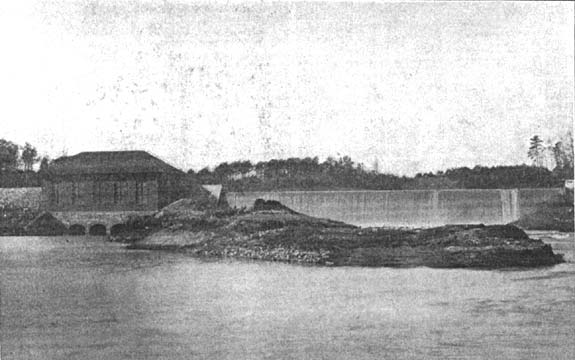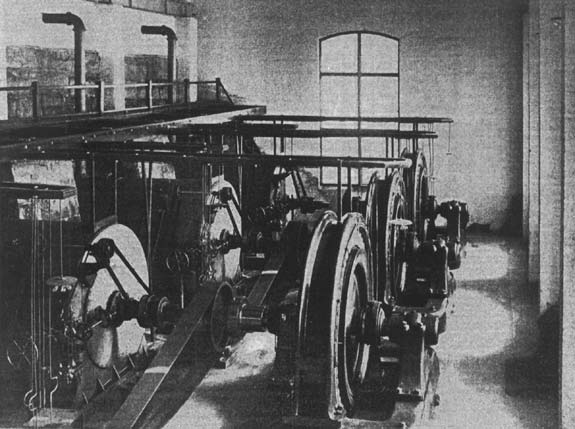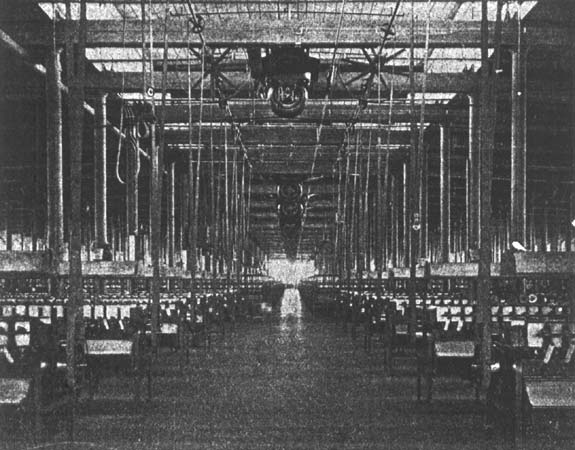[Trade Journal]
Publication: American Electrician
New York, NY, United States
vol. 12, no. 11, p. 513-515, col. 1-3
ALTERNATING-CURRENT MOTORS IN A LARGE TEXTILE MILL.
ELECTRICAL TRANSMISSION OF POWER
AT PELZER, S. C.
BY A. F. M'KISSICK.
The first case of adoption of electricity in the South as a means of transmission of power for a cotton mill was that of the Columbia Mills at Columbia, S. C., early in 1894. Prior to that time the power for cotton mills was produced either from steam engines or turbines and transmitted by means of belts or ropes. In a great many towns and cities in the South the question of water or steam was not considered for the reason that there was no available water-power convenient. Before the fact was established that power could be transmitted successfully by electricity a great many water-powers in the South were considered unavailable on account of the distance of the water-power from the railroads, or the lack of a convenient and satisfactory site for a mill that would not require excessive excavations and foundations. But when electrical transmission of power became no longer an experiment, and the question of distance not such an item, a large increase in the development of water-powers resulted.
| |||
| Fig. 1. Showing the Unostentatious Appearance Possible to An Important Power Generating Station. |
One of the most interesting and important water-power developments in the South within recent years is that accomplished by the Pelzer Manufacturing Company at Pelzer, S. C., a short time after the starting of the Columbia Mills. This company at the beginning of 1894 had in operation mills Nos. 1, 2 and 3, aggregating 52,000 spindles, mills Nos. 1 and 2 being driven by water wheels, and mill No. 3 by a 450-h.p. steam engine. It was determined at this time by the management to build another mill of 68,000 spindles capacity. For the operation of this mill it was decided to make use of a water-power 2 1/2 miles lower down the river, and transmit the power by electricity to the new mill, which was to be located on a level site near the old mills, and thus gain the very great advantage of having all the mills together; at the same time it was planned to develop sufficient power to enable mill No. 3 to be driven by a motor instead of a steam engine. The contract tor the whole electrical installation, including three 1000-h.p. generators, one 450-h.p. synchronous motor tor mill No. 3, and all the motors, transformers and other electrical apparatus for mill No. 4, was awarded to the General Electric Company.
POWER HOUSE AND DAM.
To obtain the necessary fall and at the same time a sufficient reservoir for the storage of water, a dam 32 ft. high and 450 ft. long was built across the Saluda River. This dam has since been added to so that there is now a fall of 39 ft. The face of the power house is located on the line of the dam, as shown in Fig. 1. The power house is provided with wheel pits and feeders tor five pairs of horizontal wheels, each pair capable of developing approximately 1200 horse-power. Three pairs of wheels with direct-connected generators have already been installed. Fig. 2 shows a view of the interior of the power house. The generators are the General Electric standard revolving-armature three-phase type, of 750 kilowatts output at 3600 volts, giving 60 cycles per second, and the turbines are the Victor, made by the Stilwell-Bierce & Smith-Valle Company, Dayton, Ohio, with Giesler electro-mechanical governors. The generators are operated in parallel and feed the lines direct without the intervention of transformers. In connecting these machines in multiple, the use of a synchronizing device, such as lamps, is avoided, although the switchboard is equipped with phasing lamps; paralleling is accomplished by connecting all three machines together before starting up, and then gradually speeding up the machines and exciting them as the speed goes up. This operation is performed very quickly and is very satisfactory.
A traveling crane of 15 tons capacity is provided in the power house, the track for which is supported upon pilasters built upon the interior of the power-house walls.
The line consists of eighteen No. 00 bare copper wires, the wires of each phase being on an individual cross-arm. On the top cross-arm are strung two "buckthorn" wires for lightning protection, these being grounded at every fourth pole. The wires on the bottom cross-arm are the telephone wires, which are transposed at every sixth pole to nullify induction troubles as much as possible.
| |||
| Fig. 2. Interior of Generator Room of the Pelzer Power House. |
The synchronous motor operating mill No. 3 receives current direct from the line and is self-starting. It is connected to the main shaft of mill No. 3 by means of a rope drive, and this shaft is so arranged that the whole load can be thrown on either the motor or the engine, or the load divided between the two. The saving of coal, oil and labor by the use of this motor is a considerable item.
Mill No. 4 is equipped throughout with motors, and for its operation depends entirely on electrical transmission of power. There are in use in the mill twenty-eight motors, not including two small motors which drive blowers for cooling the transformers. The wires lead into a tower at the corner of the building, where the lightning arresters at this end of the line are located. From this tower the wires go underground in a tunnel to the transformer room, where are installed three 275-kw. transformers and six 165-kw. transformers. These transformers are artificially cooled by an air blast from two fans driven by 10-h.p. motors. In addition to this ventilation there is in operation a suction fan which draws out the hot air from the transformer room.
From the transformer room wires lead to each motor, which are distributed through the mill as follows; Basement. One 50-h.p. motor, operating cloth-room machinery and elevators, and one 50-h.p. motor operating aerophor pumps and heating apparatus. First floor Four 75-h.p. motors operating picker-room machinery, and four 130-h.p. motors operating 1580 looms on the first and second floors. Second floor. One 130-h.p motor operating 28 spinning frames. Third floor Three 130-h.p. motors and two 30-h.p. motors operating carding-room machinery. Fourth floor Nine 130-h.p. motors and tour 50-h.p. motors operating spinning frames, warpers and spoolers. In addition to the motors here enumerated there are three small induction motors driving pumps, and one driving the machinery in the foundry.
Fig. 3 gives a view of the motors in the spinning room, which shows how they are attached to the ceiling. It has been found necessary in the spinning and carding rooms to use the squirrel-cage type of motor on account of the excessive lint and flyings in those rooms. This style of motor, while it takes a very heavy starting current, after it is once started gives good satisfaction. All the other motors in the mill are of the clutch type, with variable resistance in the circuit of the rotating secondary element. These motors are cleaned dally, being blown out with compressed air.
| |||
| Fig. 3. Spinning Machinery Driven by Ceiling Motors. |
In order to increase the power factor of this plant a 400-kw. rotary condenser, which is simply an over-excited synchronous motor running tree, was installed during the summer of, 1899. This condenser motor is connected in multiple to the secondary 220-volt mains so that by its use the wattless currents in transformer line and generators are reduced, thus giving a lower temperature in the transformers and the generator and less inductive drop in the line; the reduction in inductive drop allowed the generator e.m.f. to be reduced 90 volts with the same impressed e.m.f. at the motor terminals as formerly. The reduction of the current output varied from 8 to 11 per cent. This condenser motor is self-starting from rest, and after once being started and adjusted needs no attention. Repeated tests have shown that this condenser has no effect on the turbine gate opening; that is, the amount of power it saves by the reduction of heat losses in the transformers, line and generators, and in the diminished exciting power required for the generator, practically balances the power required tor the operation of the condenser motor itself. The exciter of the condenser motor is on the same shaft, so that the machine is a very simple one and works very satisfactorily. Its capacity as a condenser can be quickly varied to suit the character of the load. When the synchronous motor at mill No. 3 is running alone, there is absolutely no need tor the condenser motor. The power factor of this plant with full load on, without the condenser motor, is 86 per cent, and with the condenser it is 94 per cent. The following readings are given to show the effect of the condenser motor:
 |
In the above test the e.m.f. at the motor terminals was kept constant. It was found necessary, on account of the low water in summer, to supplement the water-power at mills Nos. 1 and 2 with steam-power, and bearing in mind the fact that mill No. 4 would also suffer from low water, it was decided to put in at mills Nos. 1 and 2 a steam engine of sufficient size to supplement the water-power of mills Nos. 1 and 2, and also to drive a 1000-h.p. generator for assisting mill No. 4 during low-water periods. This generator is a General Electric revolving-field alternator and feeds into the line system, being put in phase by means of lamps. An Important feature is that this generator can be made to run as a motor, so that the installation of the machine connected mills Nos. 1, 2, 3 and 4 together, so far as power is concerned.
One of the interesting points noted in connection with the working of the plant is the difference in power required in summer and in winter-time. In summer-time, with the maximum head of water, and all four mills running on water, there is between 350 and 400 horse-power to spare; but in the middle of winter, with the maximum head of water at each pond, there is always, in the early morning, a deficiency in power, causing the speed to be a few revolutions slow. This deficiency gradually diminishes, until finally, toward the middle of the day, there is actually a surplus of power. So that it is found economical, leaving out all questions of health or comfort, to keep these mills well heated in winter. In these comparisons the load in each case was practically the same, including lamps and motors.
Since the addition of machinery to mill No. 4, two years ago, it was found that even with the maximum head of water the power house was unable to drive mill No. 4 and mill No. 3. This trouble was obviated, however, by utilizing the surplus power of mills Nos. 1 and 2 (about 250-horse-power) by means of the reserve generator, which enabled everything to be driven primarily with water-power. In times of low water the reserve engine at No. 3 mill is operated, and also the large one under mill No. 1, which is connected in with the turbines during mills Nos. 1 and 2.



